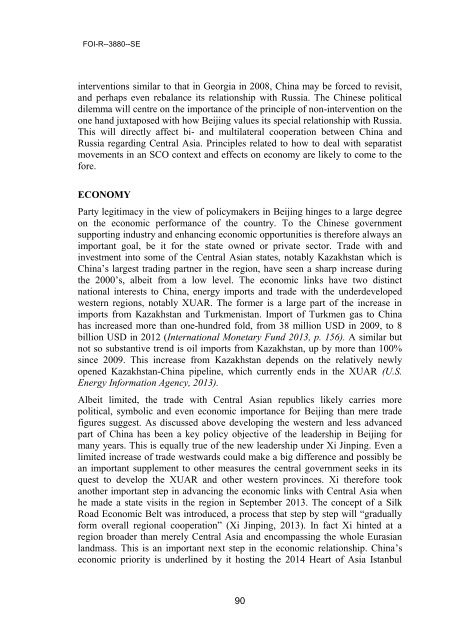foir_3880
foir_3880
foir_3880
Create successful ePaper yourself
Turn your PDF publications into a flip-book with our unique Google optimized e-Paper software.
FOI-R--<strong>3880</strong>--SE<br />
interventions similar to that in Georgia in 2008, China may be forced to revisit,<br />
and perhaps even rebalance its relationship with Russia. The Chinese political<br />
dilemma will centre on the importance of the principle of non-intervention on the<br />
one hand juxtaposed with how Beijing values its special relationship with Russia.<br />
This will directly affect bi- and multilateral cooperation between China and<br />
Russia regarding Central Asia. Principles related to how to deal with separatist<br />
movements in an SCO context and effects on economy are likely to come to the<br />
fore.<br />
ECONOMY<br />
Party legitimacy in the view of policymakers in Beijing hinges to a large degree<br />
on the economic performance of the country. To the Chinese government<br />
supporting industry and enhancing economic opportunities is therefore always an<br />
important goal, be it for the state owned or private sector. Trade with and<br />
investment into some of the Central Asian states, notably Kazakhstan which is<br />
China’s largest trading partner in the region, have seen a sharp increase during<br />
the 2000’s, albeit from a low level. The economic links have two distinct<br />
national interests to China, energy imports and trade with the underdeveloped<br />
western regions, notably XUAR. The former is a large part of the increase in<br />
imports from Kazakhstan and Turkmenistan. Import of Turkmen gas to China<br />
has increased more than one-hundred fold, from 38 million USD in 2009, to 8<br />
billion USD in 2012 (International Monetary Fund 2013, p. 156). A similar but<br />
not so substantive trend is oil imports from Kazakhstan, up by more than 100%<br />
since 2009. This increase from Kazakhstan depends on the relatively newly<br />
opened Kazakhstan-China pipeline, which currently ends in the XUAR (U.S.<br />
Energy Information Agency, 2013).<br />
Albeit limited, the trade with Central Asian republics likely carries more<br />
political, symbolic and even economic importance for Beijing than mere trade<br />
figures suggest. As discussed above developing the western and less advanced<br />
part of China has been a key policy objective of the leadership in Beijing for<br />
many years. This is equally true of the new leadership under Xi Jinping. Even a<br />
limited increase of trade westwards could make a big difference and possibly be<br />
an important supplement to other measures the central government seeks in its<br />
quest to develop the XUAR and other western provinces. Xi therefore took<br />
another important step in advancing the economic links with Central Asia when<br />
he made a state visits in the region in September 2013. The concept of a Silk<br />
Road Economic Belt was introduced, a process that step by step will “gradually<br />
form overall regional cooperation” (Xi Jinping, 2013). In fact Xi hinted at a<br />
region broader than merely Central Asia and encompassing the whole Eurasian<br />
landmass. This is an important next step in the economic relationship. China’s<br />
economic priority is underlined by it hosting the 2014 Heart of Asia Istanbul<br />
90


